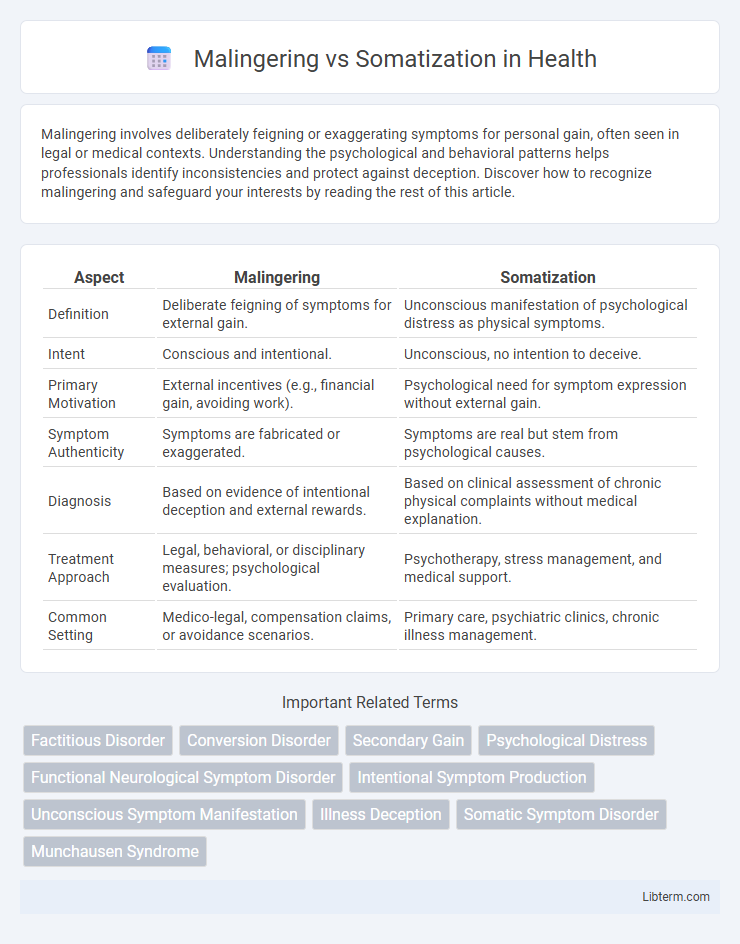Malingering involves deliberately feigning or exaggerating symptoms for personal gain, often seen in legal or medical contexts. Understanding the psychological and behavioral patterns helps professionals identify inconsistencies and protect against deception. Discover how to recognize malingering and safeguard your interests by reading the rest of this article.
Table of Comparison
| Aspect | Malingering | Somatization |
|---|---|---|
| Definition | Deliberate feigning of symptoms for external gain. | Unconscious manifestation of psychological distress as physical symptoms. |
| Intent | Conscious and intentional. | Unconscious, no intention to deceive. |
| Primary Motivation | External incentives (e.g., financial gain, avoiding work). | Psychological need for symptom expression without external gain. |
| Symptom Authenticity | Symptoms are fabricated or exaggerated. | Symptoms are real but stem from psychological causes. |
| Diagnosis | Based on evidence of intentional deception and external rewards. | Based on clinical assessment of chronic physical complaints without medical explanation. |
| Treatment Approach | Legal, behavioral, or disciplinary measures; psychological evaluation. | Psychotherapy, stress management, and medical support. |
| Common Setting | Medico-legal, compensation claims, or avoidance scenarios. | Primary care, psychiatric clinics, chronic illness management. |
Introduction: Understanding Malingering and Somatization
Malingering involves the intentional fabrication or exaggeration of symptoms for external gain, such as financial compensation or avoiding responsibilities. Somatization refers to the unconscious experience and expression of psychological distress through physical symptoms without an identifiable medical cause. Differentiating these conditions is critical for accurate diagnosis and appropriate treatment strategies in clinical settings.
Definition of Malingering
Malingering is the intentional fabrication or exaggeration of physical or psychological symptoms for external gain, such as financial compensation, avoiding work, or evading legal responsibility. It contrasts with somatization, where symptoms arise unconsciously and are not voluntarily produced. Understanding malingering requires identifying deliberate deception aimed at achieving a specific benefit.
Definition of Somatization
Somatization is a psychological condition where individuals experience and report physical symptoms without a detectable medical cause, often linked to emotional distress or mental health disorders. Unlike malingering, which involves the intentional fabrication or exaggeration of symptoms for external gain, somatization occurs unconsciously and is not deliberate. This disorder is prevalent in somatic symptom disorder and often requires integrated medical and psychiatric evaluation for accurate diagnosis and treatment.
Key Differences Between Malingering and Somatization
Malingering involves intentionally fabricating or exaggerating symptoms for external gain, such as financial compensation or avoiding responsibilities, while somatization refers to the unconscious experience of physical symptoms without a medical explanation. Key differences include the conscious deception present in malingering versus the genuine distress and symptom manifestation in somatization disorder. Diagnostic criteria emphasize the motivation behind symptom presentation, with malingering driven by external incentives and somatization linked to psychological factors causing real physical complaints.
Psychological Mechanisms Behind Malingering
Malingering involves the intentional fabrication or exaggeration of symptoms driven by external incentives such as financial gain, avoiding work, or evading legal responsibility. Psychological mechanisms behind malingering include conscious decision-making processes aimed at achieving a specific goal, often linked to secondary gain, and strategic symptom presentation to deceive evaluators. In contrast, somatization reflects unconscious psychological distress manifesting as physical symptoms without deliberate deception.
Psychological Mechanisms Behind Somatization
Somatization involves the psychological mechanism where emotional distress manifests as physical symptoms without identifiable medical causes, often linked to unconscious processes and heightened bodily awareness. This contrasts with malingering, which entails deliberate fabrication or exaggeration of symptoms for tangible external incentives such as financial gain or avoidance of responsibilities. Understanding somatization requires acknowledging the complex interplay of stress, trauma, and neurobiological factors contributing to symptom development.
Clinical Signs: Identifying Malingering
Identifying malingering involves recognizing inconsistencies between reported symptoms and clinical findings, such as exaggerated complaints or symptoms that do not conform to typical medical patterns. Patients may demonstrate evasive behavior during examination or show a lack of cooperation when their deceit is suspected. Objective assessments, including psychological testing and corroborative evidence, are essential in distinguishing malingering from somatization, where symptoms are genuine but not intentionally produced.
Clinical Signs: Identifying Somatization
Clinical signs of somatization include multiple, recurrent physical complaints across various organ systems without an identifiable medical cause, often accompanied by excessive anxiety about health. Patients with somatization typically report symptoms such as pain, gastrointestinal distress, or neurological issues that persist over time and are inconsistent with clinical findings. Unlike malingering, which involves intentional symptom fabrication for external gain, somatization reflects genuine distress driven by psychological factors rather than conscious deception.
Diagnostic Approaches and Assessment Tools
Malingering involves the intentional fabrication or exaggeration of symptoms for external gain, assessed using tools like the Structured Interview of Reported Symptoms (SIRS) and the Test of Memory Malingering (TOMM). Somatization, characterized by the presentation of genuine physical symptoms without identifiable medical causes, is commonly evaluated through the Somatic Symptom Scale-8 (SSS-8) and clinical interviews focused on psychosomatic correlations. Differential diagnosis requires careful integration of psychological evaluations, symptom validity tests, and patient history to distinguish between conscious deception and unconscious symptom expression.
Implications for Treatment and Management
Malingering involves intentional fabrication or exaggeration of symptoms for external gain, requiring treatment approaches that focus on forensic assessment and behavioral management, often involving legal or occupational intervention. Somatization is characterized by unconscious, genuine physical symptoms without identifiable medical causes, necessitating a biopsychosocial approach including psychotherapy, stress management, and coordinated care to address underlying psychological factors. Effective management depends on accurate diagnosis to differentiate these conditions, as malingering may require confrontation and monitoring, whereas somatization benefits from empathetic validation and multidisciplinary treatment plans.
Malingering Infographic

 libterm.com
libterm.com